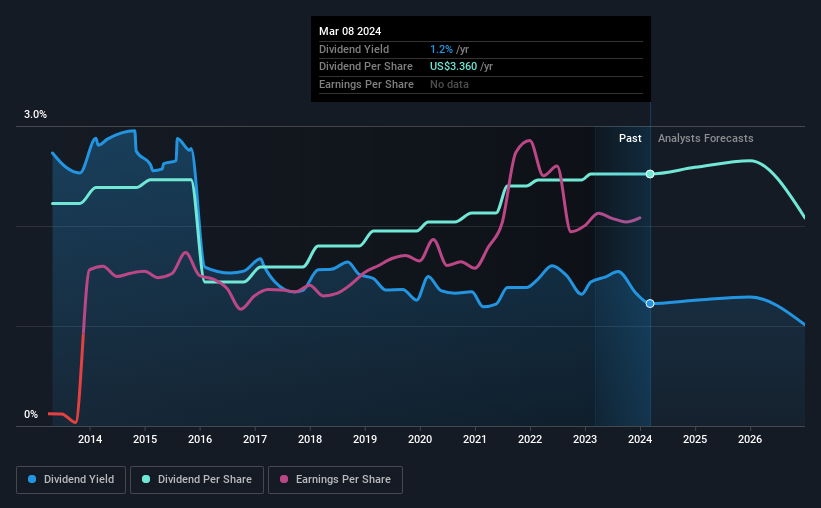- United States
- /
- Insurance
- /
- NasdaqGS:WTW
Willis Towers Watson (NASDAQ:WTW) Is Increasing Its Dividend To $0.88

The board of Willis Towers Watson Public Limited Company (NASDAQ:WTW) has announced that it will be increasing its dividend by 4.8% on the 15th of April to $0.88, up from last year's comparable payment of $0.84. This takes the annual payment to 1.2% of the current stock price, which unfortunately is below what the industry is paying.
See our latest analysis for Willis Towers Watson
Willis Towers Watson's Dividend Is Well Covered By Earnings
If it is predictable over a long period, even low dividend yields can be attractive. Before making this announcement, Willis Towers Watson was easily earning enough to cover the dividend. This means that most of its earnings are being retained to grow the business.
The next year is set to see EPS grow by 60.5%. If the dividend continues along recent trends, we estimate the payout ratio will be 21%, which is in the range that makes us comfortable with the sustainability of the dividend.

Dividend Volatility
Although the company has a long dividend history, it has been cut at least once in the last 10 years. Since 2014, the dividend has gone from $2.97 total annually to $3.36. This works out to be a compound annual growth rate (CAGR) of approximately 1.3% a year over that time. It's encouraging to see some dividend growth, but the dividend has been cut at least once, and the size of the cut would eliminate most of the growth anyway, which makes this less attractive as an income investment.
The Dividend Looks Likely To Grow
Growing earnings per share could be a mitigating factor when considering the past fluctuations in the dividend. It's encouraging to see that Willis Towers Watson has been growing its earnings per share at 14% a year over the past five years. A low payout ratio and decent growth suggests that the company is reinvesting well, and it also has plenty of room to increase the dividend over time.
Willis Towers Watson Looks Like A Great Dividend Stock
Overall, we think this could be an attractive income stock, and it is only getting better by paying a higher dividend this year. The company is easily earning enough to cover its dividend payments and it is great to see that these earnings are being translated into cash flow. All of these factors considered, we think this has solid potential as a dividend stock.
Companies possessing a stable dividend policy will likely enjoy greater investor interest than those suffering from a more inconsistent approach. Still, investors need to consider a host of other factors, apart from dividend payments, when analysing a company. For instance, we've picked out 2 warning signs for Willis Towers Watson that investors should take into consideration. Is Willis Towers Watson not quite the opportunity you were looking for? Why not check out our selection of top dividend stocks.
Valuation is complex, but we're here to simplify it.
Discover if Willis Towers Watson might be undervalued or overvalued with our detailed analysis, featuring fair value estimates, potential risks, dividends, insider trades, and its financial condition.
Access Free AnalysisHave feedback on this article? Concerned about the content? Get in touch with us directly. Alternatively, email editorial-team (at) simplywallst.com.
This article by Simply Wall St is general in nature. We provide commentary based on historical data and analyst forecasts only using an unbiased methodology and our articles are not intended to be financial advice. It does not constitute a recommendation to buy or sell any stock, and does not take account of your objectives, or your financial situation. We aim to bring you long-term focused analysis driven by fundamental data. Note that our analysis may not factor in the latest price-sensitive company announcements or qualitative material. Simply Wall St has no position in any stocks mentioned.
About NasdaqGS:WTW
Willis Towers Watson
Operates as an advisory, broking, and solutions company worldwide.
Reasonable growth potential with adequate balance sheet.
Similar Companies
Market Insights
Community Narratives




